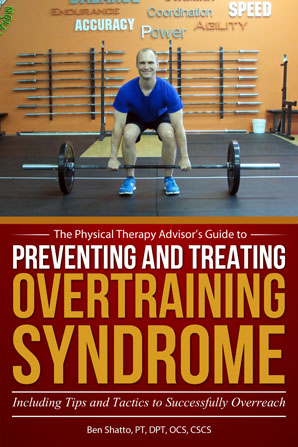If you exercise or participate in any sport, then you have likely had some experience with Overtraining Syndrome (OTS). It usually starts with extra muscle soreness and a feeling of fatigue. These symptoms can quickly morph into a serious case of Overtraining Syndrome. OTS can ruin your ability to effectively train, compete or even exercise for weeks, months and in some extreme cases, even years.
Although not well understood yet, research indicates there are two forms of OTS. One affects the sympathetic nervous system (SNS). The other primarily affects the parasympathetic nervous (PNS). Sympathetic OTS tends to affect sprint or power athletes. The resting heart rate tends to be elevated in the sympathetic form. Parasympathetic OTS tends to affect endurance athletes. In the parasympathetic form, the heart rate is even more decreased than typically found in endurance athletes.

To effectively train at a high level one must avoid Overtraining Syndrome. It not only impedes your immediate performance, but it also substantially increases your risk of injury. Injury is one of the most common reason people do not meet their training and exercise goals. To train at a high level, you must put as much emphasis on your recovery protocol as your actual training plan. Your recovery routine should be an intentional and a multifaceted approach.
How to Prevent Overtraining Syndrome (OTS):
Monitor heart rate variability
Another potential warning factor for Overtraining Syndrome is heart rate variability (HRV). It is simply the variation in the time interval between heartbeats. HRV is affected by stress, hormone changes, and changes in the sympathetic or parasympathetic system. A reduced HRV is a sign of OTS. The higher the HRV, the more capable your nervous system is able to adapt to stress.
Active recovery
Every day shouldn’t be an intense training day. As part of your training cycles, be sure to include time to participate in other activities to help the body to recover and rejuvenate. Participate in a yoga class, take a leisurely bike ride or take a walk in the park.
Proper periodization
You cannot and should not train at a super high intensity all year long. Your work volume needs to be properly periodized. Well-balanced gradual increases in training are recommended. Be sure your training plan varies the training load in cycles with built in mandatory rest phases throughout the year.
Taper up the training volume appropriately
The 10 Percent Rule is a guideline that many fitness experts use to help athletes (of all levels) avoid injury while improving performance. Many cases of OTS can be attributed to increasing the intensity, time or type of activity too quickly. The 10 Percent Rule sets a weekly limit on training increases. The guideline indicates not to increase your activity more than 10 percent per week.
Rest more
Your body must rest in order to grow and develop. Training every day is not the best way to improve. It can lead to injury and burn out. Take a rest day and have fun. Sleep more. Proper programming includes mini cycles with an off season as well as active rest cycles in between heavy load and heavy volume training cycles. Don’t fear rest, embrace it!
Eat healthy
Your body tissue needs nutrients to be able to perform at a high level. Avoid processed food as much as possible. Limit sugary food and add more protein and healthy fat in your diet. Maintaining a diet with adequate healthy fats is essential in providing the nutrients to support all hormone function in the body as well as support the brain and nervous system. Adequate protein intake is necessary to support muscle health and development.
Stay hydrated
The human body is primarily made of water, which is critical for all body functions. Adequate water intake is critical to avoid dehydration which can negatively affect your training. Dehydrated tissues are prone to injury as they struggle to gain needed nutrients to heal and repair. Dehydrated tissues are less flexible and tend to accumulate waste products. Stay hydrated by drinking water. Try to avoid beverages that contain artificial sweeteners or chemicals with names you can’t spell or pronounce.
Supplement
Appropriate supplementation can be a highly effective method to help prevent OTS. The use of proper supplementation can help your body get the nutrients it needs to support the healing and recovery process. I take certain supplements during times of heavy training volume or when I am in a phase of overreaching. I also take them intermittently to help prevent injury or heal from one.
If you begin to experience any symptoms of OTS, be proactive about modifying your training. It is important to objectively measure your training routine and make adjustments before you become sick, overtrained or injured. Nothing can derail your best laid training plans and goals like an injury or suffering from OTS! If you develop OTS, you will need to take specific steps to speed up your recovery in order to prevent injury and return to a normal training schedule.

AVAILABLE NOW ON AMAZON!
In my book, Preventing and Treating Overtraining Syndrome, I show you how to recognize the risk factors and symptoms of OTS. You’ll learn how to utilize prevention strategies to help you develop a personal training strategy that will allow you to push past your limits and prior plateau points in order to reach a state of what is known as overreaching (your body’s ability to “supercompensate”). This will speed up your results, so that you can train harder and more effectively than ever before! In addition, learn how to use the foam roller (complete with photos and detailed exercise descriptions) as part of a health optimization program, recovery program, rest day or treatment modality.
Discover how you can continue to train hard and avoid the associated poor performance, illness, and injury that can result in lost training days and opportunity!
